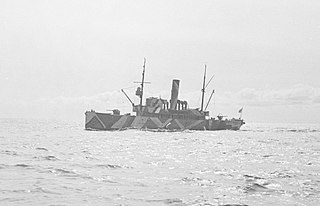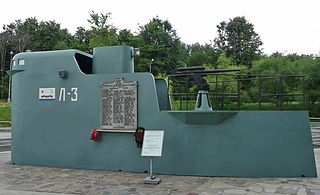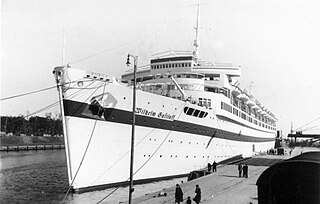
The Baltic Sea campaigns were conducted by Axis and Allied naval forces in the Baltic Sea, the Gulf of Bothnia, the Gulf of Finland and the connected lakes Ladoga and Onega on the Eastern Front of World War II. After early fighting between Polish and German forces, the main combatants were the Kriegsmarine and the Soviet Navy, with Finland supporting the Germans until 1944 and the Soviets thereafter. The Swedish Navy and merchant fleet played important roles, and the British Royal Navy planned Operation Catherine for control of the Baltic Sea and its exit choke point into the North Sea.

The Shchuka-class submarines, also referred to as Sh or Shch-class submarines, were a medium-sized class of Soviet submarines, built in large numbers and used during World War II. "Shchuka" is Russian for pike. Of this class, only two submarines entered service after 1945, although they were launched before the war.
The Black Sea Campaigns were the operations of the Axis and Soviet naval forces in the Black Sea and its coastal regions during World War II between 1941 and 1944, including in support of the land forces.

Ruotsinsalmi was a minelayer of the Finnish Navy and the namesake of her class. Ruotsinsalmi was commissioned in 1940 and remained in service until 1975. The vessel was named after the battle of Ruotsinsalmi, which was fought between Sweden and Russia in 1790.

Louhi was a Finnish Navy minelayer. The ship was originally constructed for the Imperial Russian Navy but was taken over by the Finns during the Russian Civil War. She had originally been named Voin, but was renamed as M1 in Finnish service. In 1936 she was given the more personal name Louhi, following the procedure of all other major ships in the Finnish navy.
Shch-317 was a Shchuka-class submarine of the Soviet Navy. Her keel was laid down by A. Marti in Leningrad on 23 July 1934. She was launched on 24 September 1935 and commissioned on 29 September 1936 in the Baltic Fleet.
Soviet submarine K-3 was a K-class submarine of the Soviet Navy during World War II.

Submarine warfare in the Black Sea in World War II during 1941 primarily involved engagements between submarines of the Soviet Black Sea Fleet attacking Axis merchantmen defended by Romanian and Bulgarian warships. These engagements were a part of the naval Black Sea campaigns between Axis and Soviet naval forces.
The Romanian Navy during World War II was the main Axis naval force in the Black Sea campaigns and fought against the Soviet Union's Black Sea Fleet from 1941 to 1944. Operations consisted mainly of mine warfare, but there were also escort missions and localized naval engagements. The largest naval action fought by the Romanian Navy was the 26 June 1941 Raid on Constanța, and its most extensive operation was the 1944 evacuation of the Crimea.
The action of 6 December 1941 was a confrontation between the Bulgarian and Soviet navies in the Black Sea during World War II, taking place near the Bulgarian coast at Cape Emine.

The Soviet Navy launched the Soviet submarine Baltic Sea campaign in 1942 to harass the strategic iron-ore traffic from neutral Sweden to Nazi Germany during World War II. The Soviet Union and the German Reich fought each other on the Eastern Front (1941-1945) during the war. The Allies also launched other operations - especially involving the Royal Navy - against the traffic.

The Gulf of Finland U-boat campaign lasted in the Gulf of Finland during the World War II against the Soviet Union between summer 1944 and spring 1945. During the campaign Finland switched sides and joined the Allies.
Submarine warfare in the Black Sea in World War II during 1942 involved engagements between primarily submarines of the Soviet Black Sea Fleet attacking Axis merchantmen defended by Romanian and German naval warships. These engagements were a part of the Black Sea campaigns between Axis and Soviet naval forces.

Submarine warfare in the Black Sea in World War II during 1943 involved engagements between submarines of the Soviet Black Sea Fleet attacking Axis merchantmen defended by Romanian and German naval warships, as well as and German U-boats attacking Soviet merchants on the eastern Black Sea. These engagements were a part of the Black Sea campaigns between Axis and Soviet naval forces.

Submarine warfare in the Black Sea in World War II during 1944 involved engagements between submarines of the Soviet Black Sea Fleet attacking Axis merchantmen, defended by Romanian and German naval warships, as well as German U-boats and Romanian submarines attacking Soviet merchants on the eastern Black Sea. Before the conclusion of the campaign, Romania joined the Allies after King Michael's Coup. These engagements were a part of the naval Black Sea campaigns.

The Soviet submarine Baltic Sea campaign in 1941 was launched by the Soviet Navy at the early stage of Operation Barbarossa. The offensive was hampered by the quick German ground advance and the retreat of Soviet naval vessels from the main Baltic harbors.

The Soviet submarine Baltic Sea campaign in 1944 was launched by the Soviet Navy to harass enemy shipping and naval military assets of the Nazi Germany on the Eastern Front during World War II.

The Soviet naval Baltic Sea campaign in 1945 was launched by the Soviet Navy to harass enemy shipping and naval military assets of Nazi Germany on the Eastern Front during World War II. Both submarines and surface units of the Soviet Navy were employed. The campaign scored successes during Operation Hannibal.

Shch-310 was a Shchuka-class submarine of the Soviet Navy. She operated in the Baltic Sea during the WW2. During the operations in 1942 the submarine's commander was Georgiy Yegorov.
Shch-421 was a Shchuka-class submarine of the Soviet Navy. She served in the Northern Fleet during World War II. She was led by commander Nikolai Lunin, before he was replaced by his second-in-command Fyodor Vidyayev.














